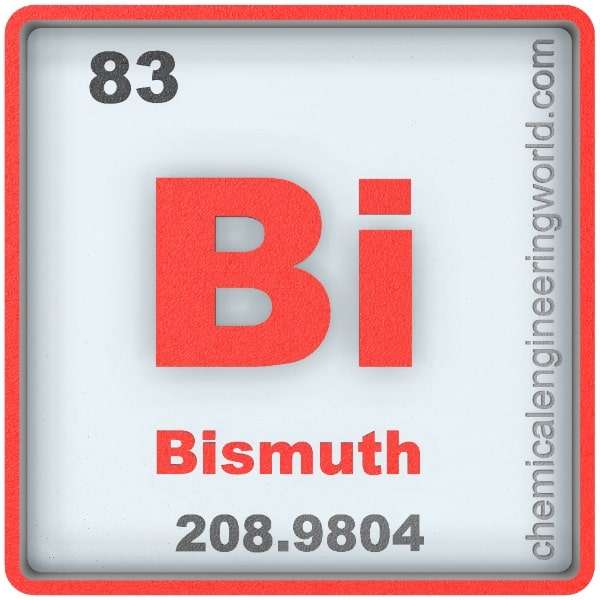Bismuth Element Properties and Information

Bismuth Element Properties and Information
Bismuth is 83rd element on the periodic table. Elements are arranged in the periodic table on the basis of the atomic number. Atomic number is the number of protons in the nucleus of the atom. Bismuth has an atomic number of 83. It is located in the Group 15 and Period 6 of the periodic table of elements. It is denoted by the symbol ‘Bi’. The name comes from ‘Bisemutum’ which is a corruption of German phrase ‘Weisse Masse’ which means ‘White Mass’.
Bismuth was discovered in the 1400s by an alchemist whose identity is unknown. Georgius Agricola speculated in early 1500s that bismuth was a metal distinct from others; and, same was contemplated by Casper Neuman in early 1700s. Claude-François Geoffroy was the first to confirm with proof that bismuth was a new metal.
Bismuth is generally found in its native state. The most important ores of bismuth are bismite and bismuthinite.
Physical Properties
- Bismuth is a post-transition metal which is dark in appearance with silver-pink hue.
- The atomic mass of bismuth is 208.98.
- The melting point of bismuth is 271°C.
- The boiling point of bismuth is 1420°C.
- The density of bismuth is 9800 in S.I. units at 20°C.
- Bismuth is the most diamagnetic among all metals.
- Bismuth has one of the lowest thermal conductivity values.
- Bismuth displays a rhombohedral lattice structure at ambient condition. Compression tends to change the structure of bismuth: It is monoclinic at 2.55 GPa, tetragonal at 2.7 GPa, and body-centered cubic at 7.7 GPa.
- Bismuth has only one primordial isotope; bismuth-209, but, it has many radioactive isotopes.
Chemical Properties
- Bismuth is stable in dry & moist air.
- Bismuth reacts with halogens to form bismuth(III) halides. It also forms a +5 oxidation state compound with fluorine, bismuth(V) fluoride.
- Bismuth is susceptible to be attacked by hydrochloric acid, nitric acid, and sulfuric acid.
Methods of Production
Recycling: Most of the bismuth is produced as a by-product during smelting of lead, copper, and tungsten. Thus, the production is dependent on how efficient is the recycling process.
Relevance in Chemical & Related Industries
- Alloy: Bismuth is alloyed with copper, iron, and other similar metals.
- Catalyst: Bismuth is used as a catalyst for making acrylic fibers, for conversion of carbon dioxide to carbon monoxide, and fluorination of esters.
Relevance in Other Industries
- Medicine: Bismuth based compounds are used in medicines which treat peptic ulcers, syphilis, diarrhea, etc.
- Semiconductor: Bismuth telluride is a semiconductor which is used in Industries.
Health Effects on Exposure
- Acute Effects: Irritation of the organs, nausea, skin reactions, diarrhea, loss of appetite, headache, fever, sleeplessness, depression, etc.
- Chronic Effects: Damages liver and kidneys.
Effects on Surroundings
Bismuth is not considered to be toxic to environment.
References:
https://en.wikipedia.org/wiki/Bismuth
































